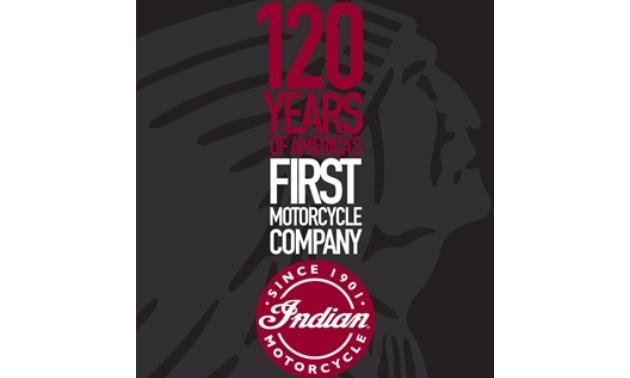America’s first motorcycle company, Indian Motorcycle, has a long history of winding roads. Indian Motorcycle: 120 Years of America’s First Motorcycle Company chronicles the mountaintop highs and valley lows throughout the storied organization’s journey.
Darwin Holmstrom guides readers from its start as a bicycle manufacturer to the purchase of the brand by Polaris Industries in 2011 and the subsequent new Indian motorcycles—updated to include new photography, the story of the latest models, including the FTR1200, Chieftain, Challenger, and Roadmaster, and Indian's return to racing.
In the early years of the 20th century, Indian dominated the world's racetracks and showrooms, earning the brand a worldwide reputation for quality, performance, reliability, and technical innovation with such classic machines as the Chief, Scout and Four. But the once-mighty company fell on hard times and in 1953 was forced to file bankruptcy.
The Indian brand never quite died, however, thanks in large part to fanatically devoted enthusiasts, who tried to resurrect it for over half a century. Finally, Polaris, maker of the highly regarded Victory brand of motorcycles, purchased the brand and released the Chief and Scout, models that once again restored Indian to its rightful place in the motorcycle pantheon.
Publishing November 17, 2020, Indian Motorcycle: 120 Years of America’s First Motorcycle Company is the most complete and up-to-date history of this classic American motorcycle.
Here are some of the intriguing highlights found within Indian Motorcycle: 120 Years of America’s First Motorcycle Company:
Chapter 1: Birth of an Icon
- Indian Motorcycles expanded rapidly in its first decade. In 1908, Indian’s factory produced 3,257 motorcycles, up from the 2,176 it had produced the previous year.
- When introduced in late 1901, the Indian “motocycle” was one of the first reliable internal-combustion vehicles sold to the general public.
- Indian’s 1907 V-twin engine gave the company a massive advantage over its rivals, which were struggling to make twin-cylinder engines function at that time.
Chapter 2: Beginning of the End
- When Indian developed the 1928 Scout chassis to match the sophistication of its 45-cubic-inch engine, the company created one of the most iconic motorcycles of all time: the Series 101 Scout.
Chapter 3: Great Motorcycles and Hard Times
- The 1930 Chief was one of the most elegant motorcycles on the market; unfortunately, the market was in complete disarray because of the Great Depression.
- Though Indian motorcycles are so associated with the colour red that the company called its most popular shade of red “Indian red,” Indian motorcycles were offered in virtually any combination of colours. This was because the du Ponts also owned a paint-manufacturing company.
- Indian was ahead of the curve in marketing motorcycles to female riders.
- Police departments continued to be an important part of Indian’s customer base in 1940. After the United States entered World War II the following year, police departments would virtually become Indian’s only non-military customers.
Chapter 4: Death of an Icon
- The US military commissioned both Harley-Davidson and Indian to develop motorcycles with the same qualities as the BMWs used by German troops in North Africa.
- The 27-cubic-inch (440-cubic-centimetre) Scout was supposed to have been Indian’s top model for 1949, but production problems and reliability issues made it a sales disaster.
- On paper, the new Scout models had everything needed to take on the competition, but out on the road they proved virtually unusable.
- Indian’s graphics were as stylish as ever in 1951, but the company’s reputation was mud.
- By 1951, most of the bugs had been worked out of the modular twin-cylinder engine, though few people cared by that point.
- The 1951 Warrior TT was the high-performance version of the Warrior, though after the debacle of the 1949 Scout, few people were interested in buying the new lightweight Indians.
- The 1953 Chief represents the very last of a once-proud line of motorcycles. It would be many years before the Indian brand would again adorn a motorcycle that generated pride.
Chapter 5: Resurrection
- With the shapely tank, Indian Motorcycle managed to complement both the modern industrial aesthetic of the new Scout and pay homage to the original at the same time.
- Indian Motorcycle had just begun to use a hydraulic front fork on the Chief when production ceased early in 1953. The reborn Chief had a beefy front fork that was far more sophisticated than anything the engineers in Springfield could have conceived in the 1950s.
Chapter 6: Indian Motorcycle Rising
- For 2015, Indian Motorcycle resurrected one of the most iconic models in its history: the Scout.
- Indian Motorcycle offered virtually every accessory imaginable for its new models, including a fork pouch of genuine leather.
- Designing a fairing that captured the look of the original Chief was a challenge because the earlier bike had no fairing at all. Indian Motorcycle designers looked to the streamlined locomotives of the 1940s for inspiration.
- In 2020, Indian Motorcycle introduced a completely new line of touring motorcycles with the Challenger models. Rather than the air-cooled pushrod twins of the previous decade, this new Indian Motorcycle combined classic style with thoroughly modern running gear.








Comments